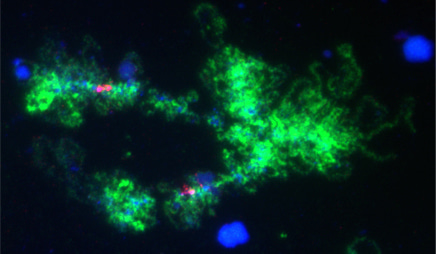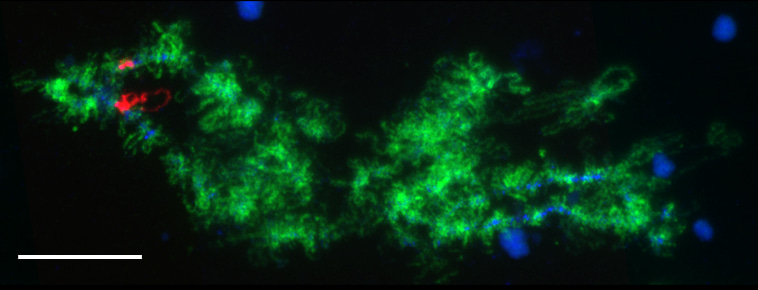Lampbrush chromosomes of zebrafish
Published in Cell & Molecular Biology, Genetics & Genomics, and Zoology & Veterinary Science

Lampbrush chromosomes in model species
Lampbrush chromosomes are not only astonishingly beautiful intranuclear structures, but also a very useful cytological system for high-resolution gene mapping, gene expression analysis and the study of transcription and co-transcriptional RNA processing mechanisms. While lampbrush chromosomes have been extensively studied in many amphibian and bird species, research on reptiles and fishes is very limited. The small aquarium fish Danio rerio is one of the most widely used model organisms in developmental biology and biopharmaceutical research. Despite intensive progress in D. rerio genome sequencing and transcriptome profiling, cytogenetic analysis of the zebrafish karyotype remains challenging.

Here we describe the lampbrush chromosomes of Danio rerio. In D. rerio, lampbrush chromosomes are approximately 20 times longer than the corresponding metaphase chromosomes. Our article also provides cytological maps of the entire set of zebrafish lampbrush chromosomes. Several lampbrush bivalents bear a set of marker structures, including locus-associated nuclear bodies. In addition to a detailed description of all lampbrush chromosomes in the karyotype, special attention is given to chromosome 4, which contains the sex-determining region.

Challenges in lampbrush chromosomes microsurgical manipulations
When we first started working with zebrafish oocytes, our initial experiments resulted in condensed lampbrush chromosomes with short lateral loops and massive chromosome axes. And it was a bit frustrating, because in amphibian and bird oocytes we usually get "fluffy" long chromosomes with extended lateral loops. So we tried switching to smaller translucent oocytes, or oocytes that had just started to accumulate yolk, and suddenly we were seeing 'real' lampbrush chromosomes - relatively long with defined lateral loops and tiny chromomeres. Such a picture can make a lampbrushologist feel quite satisfied.
The size of the oocytes with 'true' lampbrush chromosomes appeared to be very small, around 0.5 mm, which does not seem to be easy to manipulate. However, the Danio rerio oocyte nuclei appeared to be flexible and relatively stable, more like amphibian oocyte nuclei in these characteristics. Finally, isolating Danio rerio lampbrush chromosomes turned out to be not so difficult. Our new student managed to obtain several beautiful preparations of zebrafish lampbrush chromosomes right from her first experience of micromanipulation under the stereomicroscope.
We invite you to read our article, which includes the first description of the Danio rerio lampbrush chromosomes, and see for yourself just how beautiful they are.
Follow the Topic
-
Chromosome Research

This journal offers high quality papers on all aspects of chromosome and nuclear biology. Coverage emphasizes accounts of experimental studies of chromosome organization, function and behaviour. Chromosome Research publishes manuscripts from work based on all organisms.
Related Collections
With Collections, you can get published faster and increase your visibility.
Scientist Spotlights
Publishing Model: Hybrid
Deadline: Ongoing
Waldeyer-Flemming Collection
Publishing Model: Hybrid
Deadline: Ongoing





Please sign in or register for FREE
If you are a registered user on Research Communities by Springer Nature, please sign in